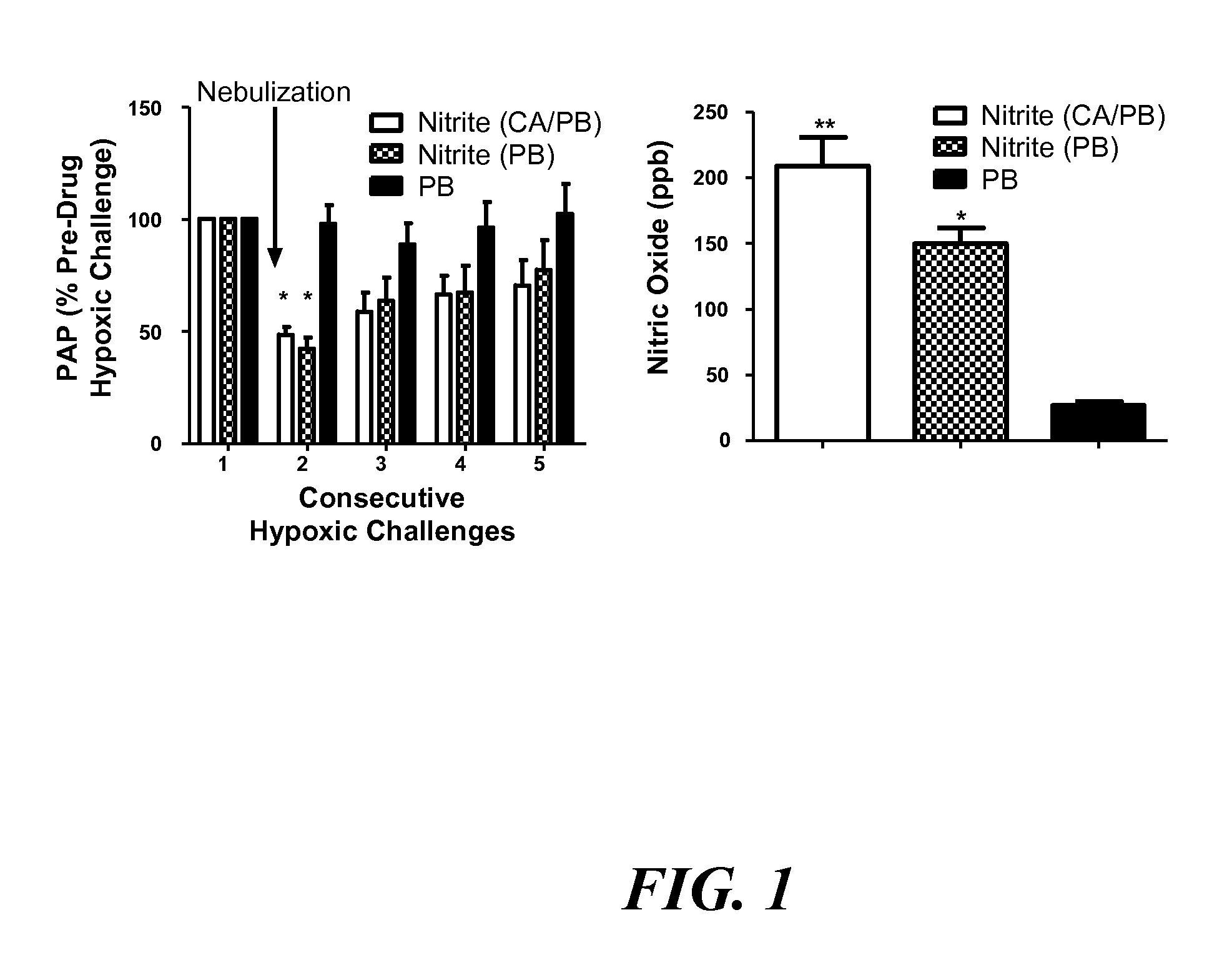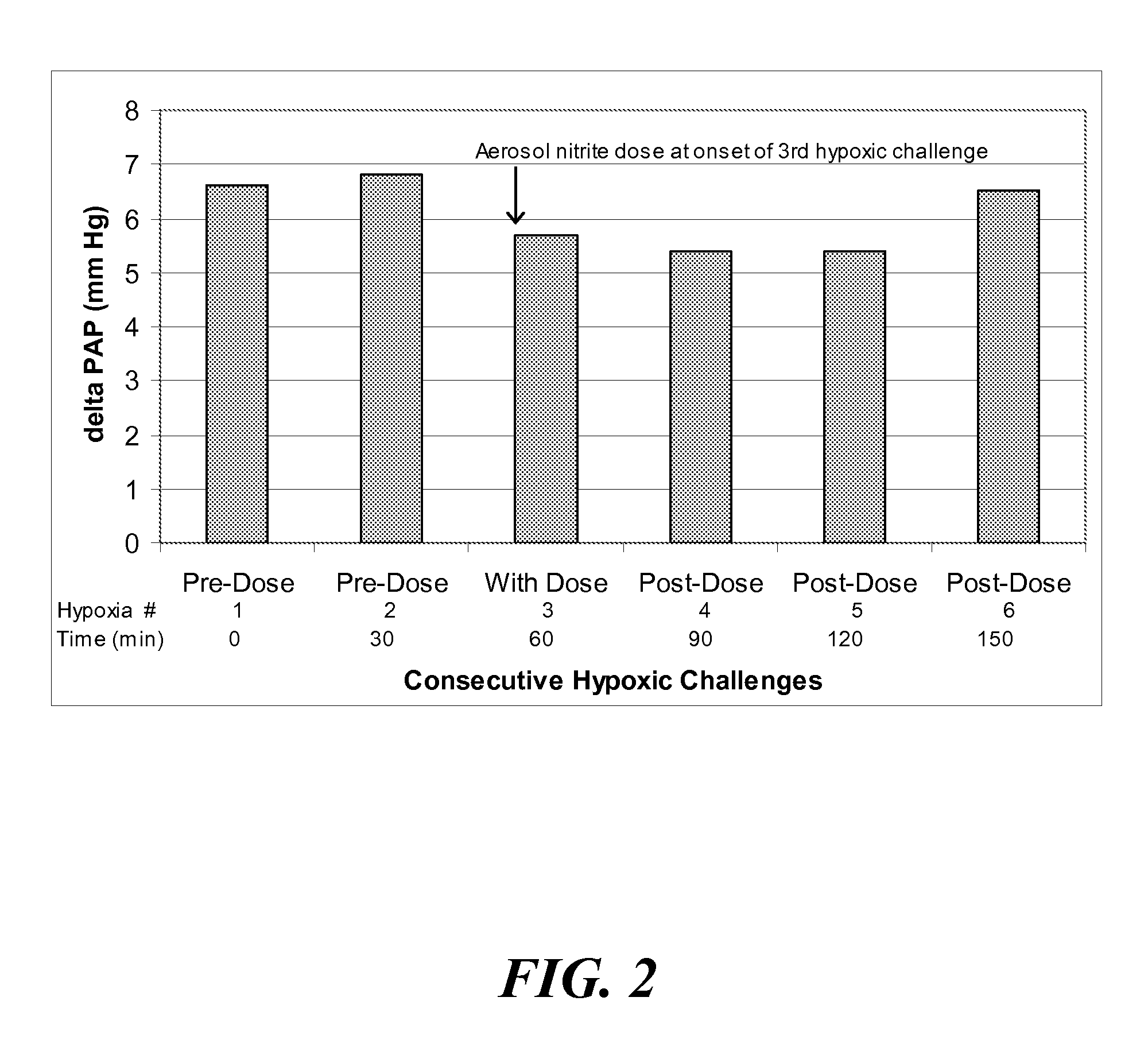Aerosolized nitrite and nitric oxide-donating compounds and uses thereof
a technology of nitrite and nitric oxide, which is applied in the direction of drug compositions, biocide, dispersed delivery, etc., can solve the problems of limited biological activity, harmful decreases in local ph and/or oxygen tension within tissues, and physicochemical factors that hinder the effective delivery of no benefits to desired tissues
- Summary
- Abstract
- Description
- Claims
- Application Information
AI Technical Summary
Benefits of technology
Problems solved by technology
Method used
Image
Examples
example 1
Pharmaceutical Development
[0376]Development activities were undertaken to obtain the following two formulation characteristics: 1. Two-vial admixture configuration: improve taste / decrease saltiness; optimize stability; final admixture pH from about 4.7 to about 6.5, preferably between 5 and 6 (facilitates generation of dissolved nitric oxide in the pre-nebulization admixed dosing solution and maintains nitric oxide in the dissolved state through nebulization and inhalation); optimize nebulization device performance (particle size and output rate); and enable flexibility in admixing the desired dose level. From these efforts it was determined that the addition of saccharin significantly reduced the salty taste associated with sodium nitrite. This improvement in taste enabled an increase in sodium nitrite concentration while in its absence sodium nitrite solution admixtures would be unpalatable. 2. Single-vial configuration: improve taste / decrease saltiness; final pH from about 7.0 to...
example 2
Aqueous Sodium Nitrite Admix Formulation for Liquid Nebulization Administration
Batches & Vial Configurations
[0417]
TABLE 14Sodium Nitrite Solution, pH 8.0 (Vial1), 4 mL fill with argon overlayChemicalMWVial Conc.Amount / VialSodium Nitrite69.00300mg / mL1200mgNaH2PO4—H2O137.996.9μg / mL0.028mgNa2HPO4—7 H2O268.0713.4μg / mL0.054mgSWFI (final vol)——4mL
[0418]1. To 50% total volume sterile water for injection (SWFI), add and dissolve:[0419]Monobasic sodium phosphate (NaH2PO4)[0420]Dibasic sodium phosphate (Na2HPO4)
[0421]2. After phosphates are dissolved in 50% total volume SWFI, add and dissolve:[0422]Sodium nitrite
[0423]3. Measure and record pH (preliminary spec 8.0+ / −0.5)
[0424]4. Adjust volume to 100% with SWFI
[0425]5. Re-measure and record pH
[0426]6. Pass entire formulation through two 0.22 μm Millipore PVDF filters in series, taking samples before and after filtration for sterility testing and nitrite quantification
[0427]7. Co-fill vials with sterile-filtered formulation and argon gas
[0428]8...
example 3
Effect of Degassing Solution and Overlay on Sodium Nitrite Solution Stability
[0454]It was predicted that the stability of aqueous solution sodium nitrite may benefit from manufacturing vials in the absence of oxygen. To assist in determining the best manufacturing process, three batches of the Vial 1 configuration were prepared and placed on ambient and accelerated stability for 2 months.
Vial 1 Manufacturing Processes.
[0455]Process 1: 300 mg / mL sodium nitrite, 0.1 mM sodium phosphate, formulated in nitrogen-sparged sterile-water for injection (SWFI), then vialed and stoppered with an argon overlay.
[0456]Process 2: 300 mg / mL sodium nitrite, 0.1 mM sodium phosphate, formulated in SWFI, then vialed and stoppered with an argon overlay.[0457]Process 3: 300 mg / mL sodium nitrite, 0.1 mM sodium phosphate, formulated in SWFI, then vialed and stoppered under ambient atmosphere.
[0458]Results from Table 19 demonstrate that each manufacturing process enables equivalent sodium nitrite solution st...
PUM
 Login to View More
Login to View More Abstract
Description
Claims
Application Information
 Login to View More
Login to View More - R&D
- Intellectual Property
- Life Sciences
- Materials
- Tech Scout
- Unparalleled Data Quality
- Higher Quality Content
- 60% Fewer Hallucinations
Browse by: Latest US Patents, China's latest patents, Technical Efficacy Thesaurus, Application Domain, Technology Topic, Popular Technical Reports.
© 2025 PatSnap. All rights reserved.Legal|Privacy policy|Modern Slavery Act Transparency Statement|Sitemap|About US| Contact US: help@patsnap.com



